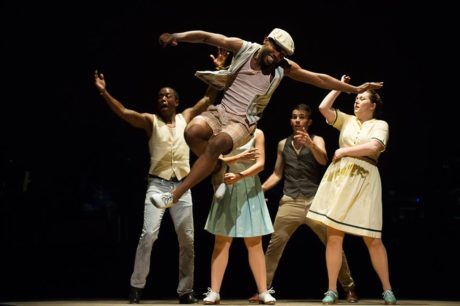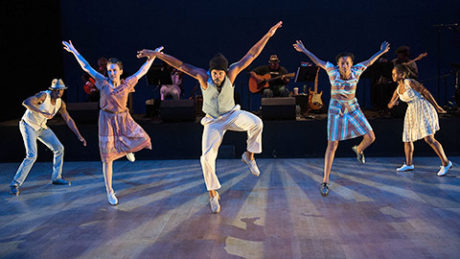If you want to know how America dances, don’t tune in to those kitschy television competition shows So You Think You Can Dance? and Dancing With the Stars.
Check out Dorrance Dance in The Blues Project. This is how America dances: with fervor and ferocity, humor and intensity, grace and fluidity, intelligence and an eye on where our people have been and where we are going. The Blues Project” digs deeply into our nation’s indigenous dance and music forms — tap and the blues – parsing its taproots in African dances and rhythms brought by slaves to American soil, Irish step dance performed by immigrants, and a culmination of fusing syncopated rhythms, stringed instruments, which evolved from West African kora to banjo, to all-American guitar and bass, and adapting heartfelt storytelling sung in ballads, spirituals and blues. The result is an astonishing and uplifting 65 minutes of grit and gumption told through body, voice, instrument, heart and soul.

On a darkened stage, the first sounds are a beat, pounded out in footwork, the sharp hit of a tap against wood, singularly and then collectively as nine dancers gather in a layered expression of body music. It’s joyful and elemental, for the beat is always reminiscent of the internal life-force: the heart. Even in the large, less-than-intimate space of The Eisenhower Theater, the performers, both dancers and musicians, manage to pull the viewers into their world, one where rhythm takes hold and leads you on a journey.
Dorrance, lanky and lean, clad in a blue-checked shirtwaist dress, comes forward last among her company of eight fine tap dancers (Christopher Broughton, Elizabeth Burke, Starinah “Star” Dixon, Claudia Rahardjanoto, Byron Tittle, and Nicholas Van Young) . Among them her co-choreographers Derick K. Grant, an original company member of the Broadway cast of the instructive and propulsive tap musical Bring In ‘Da Noise, Bring In ‘Da Funk, and Dormeshia Sumbry-Edwards, who coached Michael Jackson in tap over an 11 year period and lists Broadway credits on her resume.
Also on stage, the exquisite powerhouse singer/songwriter/guitarist Toshi Reagon. Daughter of legendary Washington-based folk, blues and spiritual song leader, singer and composer Bernice Johnson Reagon, who founded the a cappella “Sweet Honey in the Rock,” Toshi Reagon mines the aural history of America with her blues-infused rock, funk and ballads, that parses the sonic sounds of America’s roots in music.
From boldly and unabashedly spiritual forms like the Ring Shout, which dates back to slavery, to gut wrenching blues and sultry funk, Reagon carries the inflections and voices of generations expressed in their songs of oppression and hope, of slavery and freedom, that continue to resonate today.
Dorrance grew up in her mother’s ballet school in Chapel Hill, N.C., and on the soccer fields where her father coached – he led the 1991 Women’s U.S. team to the World Cup. Her combination of grace and athleticism mark her tapm but she isn’t an old school hoofer. She dances with a 21st-century sensibility and attack, knowing when to get down and hit the floor and when to lightly scuff it and caress it with staccato trembles. Her ear for the rhythmic journey and its counterpoint is impeccable. It’s hard not to notice her, even tucked into her ensemble. Unlike tap great Savion Glover, she doesn’t hide her face or turn her back on the audience, you see her ferocity of concentration as her forehead scrunches up and her eyes focus hard.
In his solo, co-choreographer Grant slyly at first throws down an old school time step. It becomes the basis for his dance rumination that meanders through a distinctive rhythm tap vocabulary while still feeling entirely of the moment to an untrained ear.
Co-choreographer Sumbry-Edwards takes her solo in a different direction, easing into it and playing off of Reagon’s guitar and bluesy and revelatory singing. Their interplay shows the necessity of having instrumentalists on stage – the four-piece ensemble (Adam Widoff on electric guitar, Fred Cash on electric bass, Juliette Jones on violin, and Allison Miller on drums) plays on a raised platform across the back of the stage. Sumbry-Edwards channels both pain and joy in her cascading hits and scuffs, slaps and shuffles, until she can’t hold back and it becomes a rush that brings her to a hard-won end. It a reckoning with the origins of tap as a way to preserve rhythms of outlawed African drums outlawed, but maintained in the body through dance and percussion called hambone.

Dorrance has incorporated her ensemble into the work in masterful ways, playing two dancers against three, a single dancer against an ensemble, quartets and trios building on layered rhythmic sets that track the evolution of tap, jazz, blues and funk. It’s a wondrous journey taken in loving recollection of America’s past. Dorrance and her eight dancers, along with Reagon and her four musicians, have let loose an evening of unfettered footwork, drawing from the most primal beats that have been kept alive for centuries to tell our true American story.
Our nation’s 19th century poet Walt Whitman wrote a song of his America, mountains, hills, valleys, workers of every stripe who built this nation. Dorrance and Reagon together sing a 21st century song of our nation’s struggles, flaws, triumphs, and hopes.
The Blues Project is exquisite embodied poetry of resilience.
Running Time: 65 minutes, with no intermission.
Dorrance Dance with Toshi Reagon and BIGLovely in The Blues Project played on Wednesday, October 5 and 6, 2016 at The Kennedy Center’s Seisenhower Theater-2700 F Street, NW, in Washington, DC. For tickets to future Kennedy Center events, go to their calendar.
RATING:




